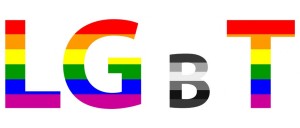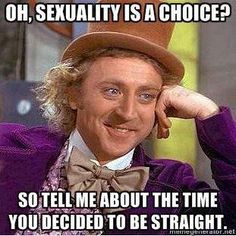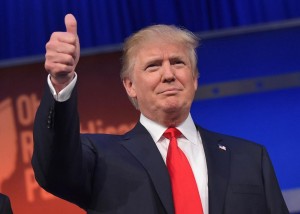The Fallacy of the Rebellious Contrarian
Sunday, May 22, 2016 by Jonathan R. Gibbons in A contrarian is “…a person who takes an opposing view, especially one who rejects the majority opinion…” (Dictionary.com). In order to be a contrarian, one must be open-minded. They are usually highly skeptical and objective; they question the norm and seek out alternative points of view. An excellent example of a contrarian position would be the position that Islamic terrorism is a direct consequence of the United States government interfering in the affairs of Middle Eastern nation-states. Non-interventionists hold this position and it is often arrived at through substantial research and questioning of the status quo. Popular mainstream opinion holds that it is radical religious views that are the core motivation for Islamic terrorism and many, like former U.S. Congressman Ron Paul, have been laughed at by their peers when they try to argue in support of a contrary position.
A contrarian is “…a person who takes an opposing view, especially one who rejects the majority opinion…” (Dictionary.com). In order to be a contrarian, one must be open-minded. They are usually highly skeptical and objective; they question the norm and seek out alternative points of view. An excellent example of a contrarian position would be the position that Islamic terrorism is a direct consequence of the United States government interfering in the affairs of Middle Eastern nation-states. Non-interventionists hold this position and it is often arrived at through substantial research and questioning of the status quo. Popular mainstream opinion holds that it is radical religious views that are the core motivation for Islamic terrorism and many, like former U.S. Congressman Ron Paul, have been laughed at by their peers when they try to argue in support of a contrary position.
Being a true contrarian– rather than a fake contrarian who simply wants to rebel for the sake of rebelling –is not easy. It comes with social consequences and sometimes even the shunning of the contrarian by their peers, friends, family, and colleagues. But contrarians are crucial to the balance that is necessary to maintain rational policy and overall cogent thinking in general. Once you stop seeking contrary ideas, you have stopped learning and have abandoned the quest for truth. Like the Stoic philosopher Epictetus said, “It is impossible for a man to learn what he thinks he already knows.”
The fallacy of the contrarian manifests when they embrace a contrary point of view and become substantially intransigent. It can be argued that they become even more close-minded than those who never had enough skepticism to seek contrary positions in the first place. At this point they have fallen back into the delusion of their less skeptical peers; they believe everything is black or white and have become blind to various shades of gray. It is the Achilles’ heel of the contrarian to become so excited about their discovered position, and so distraught at the ignorance of others for not appreciating it and mocking them, that they forget to remain in their former state of skepticism. This is the point at which a skeptic departs from the contrarian.
A skeptic is a contrarian consistently; always questioning, always listening, always ready to learn and adjust their position for the greater pursuit of truth and not the continual stroking of their rebellious ego. For example, an atheist is a contrarian; an agnostic a skeptic. Why? Because atheists have closed their mind to the potential, even if minuscule, that the theists could be right. A skeptic can always, at any point in time, be swayed to a former position, or a new one, when presented with significant evidence. Dr. Michael Shermer of Skeptic Magazine demonstrated true skepticism when he retracted his position on climate change denial and observed that the abundance of evidence for climate change was not inconsequential, but rather it was strikingly convincing.
In their book on Neuro-Linguistic Programming, Joseph O’Connor and John Seymour explain that there are four levels of learning:
- Unconscious Incompetence – initially we are entirely unaware of the existence of our gap in knowledge; we are ignorant.
- Conscious Incompetence – we then become aware of our ignorance of a subject or idea and make the decision to pursue competence.
- Conscious Competence – we are learning the new subject or idea and are deeply focused on it. For example, when you are learning to drive a car for the first time. This is the point at which you are truly open to new ideas and points of view. Like a child’s insatiable curiosity, you absorb new ideas like a sponge. You have no egotism or cockiness about the subject as you are well aware that you know very little about it. Bad teachers are, at this point, notorious for instilling their own points of view in their students; the bad liberal professor takes advantage of the student’s state of mind and “downloads” their liberalism into the student’s psyche.
- Unconscious Competence – you become so good at the activity, subject, or idea, that you can express your competence instinctively without thinking about it. You drive the car without thinking about the amount of pressure to apply to the gas. This is the point at which intransigence and stubbornness sets it. You know that whole, “you can’t teach an old dog new tricks” thing.
In order to be a true skeptic and not just a contrarian, you have to restart this learning process. Contrarians are better than mainstream followers at returning to conscious competence but once that contrary position is grasped they become stuck in unconscious incompetence to the point of intransigence. All complex subjects and issues must be approached with conscious incompetence and then discovered within conscious competence over and over to fully appreciate the various shades of gray which encompass it. Read a book on the issue in a foreign language or simply read a book about it by an author you hate. Being a skeptic is more of an art than a science as it requires an individual to adjust their inner psychology and to denounce their ego; they must be willing to confront humility if they discover that their former position was asinine. In short, don’t be a stubborn dick, be a sponge so you may be drained and then re-quenched with an abundance of points of view.
The Skeleton in the LGbT’s Closet
Sunday, April 03, 2016 by Jonathan R. Gibbons in
In this post I seek to expose the hypocrisy of biphobic homosexuals and how they are destructive to the LGBT community. I go into great depths to explain the complexities of sexual orientation and the biphobia that is present in the heterosexual community and among academic researchers as well. I dismantle such bull shit as “bisexual men do not exist,” “bisexuality is just a phase,” “sexual orientation is a choice,” and “bisexuals are less capable of monogamy than monosexuals.” Ultimately, I argue that bisexuals should abandon the LGBT community and pursue their own avenues for activism and peer-support. The LGBT community is not a good fit for them. The homosexual community has won their war against legal bigotry, but the battle for bisexuals is an intellectual one… and it is in its’ infancy.
 The Lesbian Gay bisexual & Transgender Community (LGbT) has an ugly skeleton in their closet. Many members of their community fear their bisexual counter-parts. They actually fear or loathe the concept of bisexuality in general. They wish to belittle, denounce and/or reject the very real sexual orientation of one of their core constituencies (bi erasure). Individuals who hold such views are known as biphobe’s and they are just as prevalent within the homosexual community as they are within the heterosexual community (Allen 2015 & Tangela & Hornea & Hoytb 2015). A report conducted by the Equality Network found in a survey of bisexuals that, “The highest amounts of biphobia experienced were within LGBT…” (Rankin & Morton & Bell 2015). Likewise, Beth Sherouse of the Human Rights Campaign summarizes other similar findings, specifically of bisexual youth: “’As a bisexual,’ one youth said, ‘I feel shunned by the gay and lesbian community'” (Beth 2015).
The Lesbian Gay bisexual & Transgender Community (LGbT) has an ugly skeleton in their closet. Many members of their community fear their bisexual counter-parts. They actually fear or loathe the concept of bisexuality in general. They wish to belittle, denounce and/or reject the very real sexual orientation of one of their core constituencies (bi erasure). Individuals who hold such views are known as biphobe’s and they are just as prevalent within the homosexual community as they are within the heterosexual community (Allen 2015 & Tangela & Hornea & Hoytb 2015). A report conducted by the Equality Network found in a survey of bisexuals that, “The highest amounts of biphobia experienced were within LGBT…” (Rankin & Morton & Bell 2015). Likewise, Beth Sherouse of the Human Rights Campaign summarizes other similar findings, specifically of bisexual youth: “’As a bisexual,’ one youth said, ‘I feel shunned by the gay and lesbian community'” (Beth 2015).
The dominance of biphobe’s is devastating to the well-being of young bisexuals who are trying to make sense of their sexual orientation. When they wish to come out of the closet, they will often turn to their gay friends for advice, often only to be told they are really just gay like them. With the prevalence of suicide being significantly higher among LGbT youth– and mental health problems even higher among bisexuals than homosexuals (Daily Mail Survey) –it should summon enlightened and watchful adults, to provide accurate and careful guidance to youth. Thankfully, contemporary psychology and licensed practitioners are– for the most part –fully versed and skilled in the evaluation of sexual orientation and when a young bisexual seeks out their help, they will likely obtain the guidance they need to cleanse themselves of the bull shit spewed by the biphobe’s on social media and other non-academic internet sources. But people in general turn to their peers or internet sources for help more often than a professional, so it is my goal with this post to rebuke the lies, nonsense, and destructive advice proffered by biphobe’s and to add to the currently small arsenal of objective resources available to bisexuals.
Sexual Orientation
It is important to distinguish between sexual identity and sexual orientation. Sexual identity is how someone chooses to label themselves whether publicly, privately, or internally (Bailey 2009). A woman’s sexual identity may be heterosexual but her actual orientation could be bisexual. Sexual orientation is innate. One has very little control over what they are naturally attracted to; they are born with it programmed into their core instincts. There are primarily three sexual orientation’s a person may truly possess: purely heterosexual (monosexual), bisexual, or purely homosexual (monosexual). There are variances within the spectrum of bisexuality with some individual’s being almost entirely heterosexual but slightly homosexual (hetero-flexible) or on the opposite end (homo-flexible), nonetheless, both of the latter are bisexual because they are in some way shape or form sexually and/or romantically attracted to both sexes/gender’s. So let’s not get drawn into an endless exercise of labels among sub-labels (pansexuals), among yet more sub-labels (polysexuals); these three categories have it covered.
Surprisingly, these fundamentals of psychology and sexual orientation were identified half a century ago but for some reason they remain aloof among many in the LGbT community and among many popular scholars. Alfred Kinsey was an American biologist and sexologist. In the late 1940s and early 1950s, Kinsey and his associates made the following observations:
Males do not represent two discrete populations, heterosexual and homosexual. The world is not to be divided into sheep and goats… The living world is a continuum in each and every one of its aspects.
It is a characteristic of the human mind that tries to dichotomize in its classification of phenomena…Sexual behavior is either normal or abnormal, socially acceptable or unacceptable, heterosexual or homosexual; and many persons do not want to believe that there are gradations in these matters from one to the other extreme. (The Kinsey Institute)
 Dr. Alfred Kinsey
Dr. Alfred KinseyThey ultimately developed what is known as the Kinsey Scale. This provides a visual mapping of an individuals sexuality based on a scale of 0 (heterosexual) to 6 (homosexual); bisexuals fall somewhere in the middle and may slide within this spectrum depending on various factors throughout their lifetimes. In 1978– with some enhancements in 1993 –another American sex researcher, Dr. Fritz Klein (not the Nazi), introduced the Klein Sexual Orientation Grid. Klein wanted to expand upon the research and work of Kinsey and others to provide a more elaborate view of one’s sexuality. Importantly, Klein sought to differentiate the various levels of attraction, e.g. physical attraction, emotional attraction, fantasies, and actual sexual behavior, to establish a more thorough sexual orientation (American Institute of Bisexuality). Both the Kinsey Scale and the Klein Sexual Orientation Grid were important inventions in the discipline of psychology. For those interested in determining their true sexual orientation, the dating application OKCupid provides a thorough test utilizing both Kinsey and Klein’s methods which you may find helpful: The Sexuality Spectrum Test
Sources of Biphobia Among Homosexuals
 We can only speculate on the sources of biphobia within the homosexual community, but perhaps pure homosexuals fear that the existence of bisexuality throws into question their, “I was born gay,” mantra.” “If bisexuality is real, then sexual orientation can be a choice.” The problem is, bisexual is a sexual orientation that people are “born with” as well. Attraction is not a choice, it is subconscious and deeply ingrained in our core psychology; while science has not confirmed the source of homosexual attraction, attraction, in general, has well-established roots in evolutionary psychology and biology (Ridley 2003).
We can only speculate on the sources of biphobia within the homosexual community, but perhaps pure homosexuals fear that the existence of bisexuality throws into question their, “I was born gay,” mantra.” “If bisexuality is real, then sexual orientation can be a choice.” The problem is, bisexual is a sexual orientation that people are “born with” as well. Attraction is not a choice, it is subconscious and deeply ingrained in our core psychology; while science has not confirmed the source of homosexual attraction, attraction, in general, has well-established roots in evolutionary psychology and biology (Ridley 2003).
Bisexuals do not have a choice whether or not they are attracted to both sexes, but they do have a choice in deciding who to have sex with or whether or not to be monogamous with only one sexual partner. Herein lies one source for the distortions spewed by the biphobe’s. Once a bisexual individual is in a monogamous heterosexual, or homosexual, relationship, they are then presumed to be either straight or gay, but it is simply not that simple. Just because a bisexual chooses to be in a monogamous relationship, or to only have sex with one gender, that doesn’t then negate their core sexual attraction, it simply reflects their relationship choices and, perhaps, their more dominant sexual and romantic attraction at a point in time. You may hear a woman say, “I was married to a man but he hurt me so now I only date women… I was always gay and lying to myself,” or a man say, “I used to sleep with women, but I just ended up falling in love with a man… I’m gay now.” None of this changes the core sexual orientation of these individual’s. They are still bisexual. Their level of bisexuality may sway more towards one gender at one point in their life, then another at another point, and the degrees of such attraction may vary, but it does not change their core orientation.
A homosexual can no more enjoy sex with the opposite sex than a heterosexual can with the same sex; the behavior is repulsive to them. It is unlikely they would even be able to perform, i.e. hold an erection or maintain lubrication. If they receive any level of enjoyment from it– even if minuscule –it alludes to their latent bisexual tendencies. Perhaps a bisexual woman enjoys all homosexual activity but oral sex; she is still bisexual. Perhaps a man enjoys all homosexual activity but anal sex; he is still bisexual. Maybe a bisexual only fantasizes about homosexual or heterosexual behavior but doesn’t act on it; they are still bisexual because their biological attraction switches are geared towards more than one sex regardless of their actual sexual behavior and experiences. This really is not rocket science and it is dumbfounding that major scholars and leaders in the LGbT movement do not understand and/or do not articulate these obvious truths.
Lastly, a common myth about bisexuals held by biphobe’s is that they are more prone to infidelity or promiscuity. Why? Just because bisexuals have “more options” for sexual activity does not mean they are any more likely to be unfaithful than monosexuals. They likely find someone they love and are content with, and they simply fantasize from time to time about the potential for heterosexual or homosexual activity. Just as a monosexual man or woman will undoubtedly fantasize about other sexual partners than their monogamous partner. There are terrible people in the world who act on their instincts and do things like deceive and cheat, and then there are honest and faithful individuals. A person’s core sexual identity does not dictate their moral compass. The prevalence of infidelity within the monosexual community is of great abundance; many are simply wired for monogamy and many are not, regardless of their sexual orientation (Ridley 2003).
Biphobic Heterosexuals and Researchers
A discussion of biphobia would be incomplete without mentioning the unique characteristics of biphobia among heterosexuals. While in the LGbT community biphobia is prevalent against both men and women, within the heterosexual community, biphobia is strongest against bisexual men. “Bisexual men do not exist.” This myth was so strong that in 2005 researchers ran a study to support the myth (Rieger & Chivers & Bailey 2005). J. Michael Bailey explains, “Sexual orientation is commonly described in terms of sexual desire, arousal, fantasy, and attraction. Of these, only one, arousal, can be measured directly and independent of self-report” (Bailey 2009). In other words, the only way to empirically test the existence of bisexual men is to monitor them for erectile activity while watching pornography; when do they “pop a woody.”
Bailey also partook in the 2005 study where they found bisexuals to be nonexistent (Rieger et al. 2005). Wiser researchers debunked the study in 2011 (Rosenthal et al.). Honestly, you would think such research would be unnecessary when one could simply search a porn website for bisexual men and observe empirically that they maintain erections with either sex/gender, but perhaps they felt more inclined to attach nodes to men’s genitalia than to use Google. Academics have to get paid somehow after all. In the Rosenthal et al. (2011) study, they concluded that:
…some men may identify as bisexual because they are sexually aroused by both sexes, even if they experience considerably more arousal to one sex than the other. Alternatively, men with bisexual arousal patterns may experience temporal fluctuations in their attractions and arousal to men and to women. Thus, a bisexual man may be more aroused by male stimuli at one time point but by female stimuli at another time point. Further, his arousal to his less arousing sex may vary in magnitude depending on fluctuations in his attractions to that sex at any given time. (Rosenthal et al. 2011)
No shit Sherlock. Sometimes they feel like a nut and sometimes they don’t. ha. Sometimes a girl wants a hairy chested dude and other times she wants a bare chested guy. Sometimes a man wants a curvy woman and other times a skinny rail. More seriously, sometimes a man loves a woman and sometimes a woman loves a woman; sometimes they both love both. Attraction and love are not just physical, they involve a plethora of other variables. There are a variety of potential attraction switches, e.g. physical attributes (broad shoulders, slender legs, six-pack abs, hour glass curves, youth), emotional attraction (femininity, masculinity, kindness, toughness, dominance), and relational/familial attraction (high status, stability, and ambition). Just ask the ugly pickup artist; they have volumes of material to successfully seduce their more beautiful victims (Strauss 2005).
Lastly, as you review personal accounts of bisexuals, it becomes evident that both men and women express this bi erasure attitude towards male bisexuals. Neil Endicott, a writer for the Huffington Post, recounts one of his experiences telling his girlfriend that he was bisexual; she basically laughed at him and said he’s just confused (Endicott 2015). It can be speculated that there is more biphobia towards men from heterosexuals because, well, bisexual women are hot and women are far more objectified in western culture than men. It is socially acceptable, if not welcomed with a giant grin, for two women– la femme lesbians specifically –to hookup publicly but not for two men. Hence, I suspect some of this gender imbalance found among heterosexual biphobia is simply related to the cultural standard of women being the icons of sexuality and men the drooling-emasculated bystanders.
Taking Action
Bisexuals should dump the lgBt community and the LGT community should move on. The needs of the former are not the same as the latter. Biphobic homosexuals are promoting a culture that encourages bisexual’s to come out of their bisexual closet as homosexual or to remain in their bisexual closet and proclaim heterosexuality. There are young adults throughout the western world who see the nonsense that people within the lgBt community spew and they become anxious, more confused, and in a state of constant distress. Surely some homosexuals choose to lie about being bisexual instead of coming out as gay (Rosenthal et al. 2011), or they are legitimately holding onto the misguided hope that there’s a slight chance they might start liking the opposite sex. All of this is reflective of a behavior specific to homosexuals, not bisexuals. I suspect there are a plethora of closet bisexuals who simply choose to never pronounce their true sexuality as it is simply easier to fit into a “this or that” sexual dichotomy.
Ultimately how one chooses to self identify is entirely up to them. If they are only incidentally bisexual, but mostly heterosexual, then maybe they will choose to identify as straight because it is easier. But I challenge bisexuals to embrace their bisexual orientation no matter how mild it may be and regardless of their current relationship status. If they possess attraction to both sexes, no matter how minuscule, they should embrace it. Instead of saying, “I’m gay,” or, “I’m a lesbian,” or “I’m straight,” simply be accurate and honest. “I’m bisexual but in a committed relationship with a man or a woman.” Period. That’s the truth, and it will help to provide cogency to the various young adults who are struggling with their sexuality when they see how being bisexual does not mean you have to fit into some perfect pigeon hole that monosexual’s wish to foist you in.
“I call myself bisexual because I acknowledge that I have in myself the potential to be attracted– romantically and/or sexually –to people of more than one sex and/or gender, not necessarily at the same time, not necessarily in the same way, and not necessarily to the same degree.” – Robyn Ochs
Sources:
Donald Trump: His Appeal, The Good, The Bad, and Pro Wrestling?
Monday, February 29, 2016 by Jonathan R. Gibbons in
Demystifying the Attraction of Donald Trump
Donald Trump is extremely likable to a sizable portion of the American electorate. There are even notable closet Trump supporters as Novelist Bret Ellis tweeted, “Just back from a dinner in west Hollywood: shocked the majority of the table was voting for Trump but they would never admit it publicly” (USA Today). Trump is comedic, he appears genuine, and he is unfiltered. He has charisma and charm. He is fearless and has depth of fortitude. Trump towers– pun intended –over political correctness, uptight feminists, and liberal college students who cry and moan about micro-aggression’s and virtually every other little thing that hurts their feelings. Trump is not bought and paid for. Trump is the money and so he says what he wants without fear; often with comical exaggeration. He is literally self-funding the majority of his campaign just like he says; 70% of his fundraising is from self-financing to be exact (Open Secrets). He is an established and brilliant business man who made billions for his companies throughout his lifetime. People who dislike Trump say things like, “he’s an idiot,” “he’s a bully,” “he’s just a reality show star,” “he’s unhinged,” “he’s a Clinton plant,” or “he’s a clown pretending to be a serious candidate.” Love him, like him, or hate him, Trump should be admired for many things.
A slew of Americans have grown tired of “cookie-cutter” politicians, special interest dominated candidates, and the overly scripted and predictable routines of the mainstream political movers and shakers. Like the WWE pro wrestlers and story-lines of today (e.g. Roman Reigns and the Authority), the typical political candidate is overly scripted, prepared, and, well, transparently fake as hell. This is why intelligent WWE fans reject their synthetically-pushed entertainers and plots, and it is also one of the reasons voters reject Jeb Bush and Marco Rubio. Meanwhile, WWE “creative” and the political “experts” scratch their heads in bewilderment at why their generic mannequin is not winning over the audience. Chris Christie exposed Rubio for this in the 8th Republican debate when he called him out for constantly regurgitating a rehearsed 25 second speech (see the video below). One of the reasons Rand Paul failed to garner his father’s supporters was because, unlike his father, he also came off overly scripted and fake.
Like the successful pro-wrestlers of old, e.g. Steve Austin, Hulk Hogan, and The Rock, the successful political candidates rise organically. They keep it real and connect with their audience because they relate to them and give them hope. They seduce them with their natural charm and charisma and never insult their subjects intelligence; they know how to flatter. By providing the electorate with a hope or view of restoring something they feel they are lacking, these seductive candidates spark the dormant passions of the apathetic voter. Ronald Reagan and JFK are timeless examples of political seducers. In his book, “The Art of Seduction“, Robert Greene says of JFK (my emphasis):
Kennedy’s seduction of the American public was conscious and calculated. It was also more Hollywood than Washington… All of Kennedy’s actions were framed in the conventions of Hollywood. He did not argue with his opponents, he confronted them dramatically… He did not discuss policy details but waxed eloquent about grand mythic themes, the kind that could unite a divided nation (Make America Great Again!, Change!). (Greene 2001, 124-125)
Mass seducers such as Napoleon or John F. Kennedy offer their public just what it lacks. When Napoleon came to power, the French people’s sense of pride was beaten down by the bloody aftermath of the French Revolution. He offered them glory and conquest. Kennedy recognized that Americans were bored with the stultifying comfort of the Eisenhower years; he gave them adventure and risk. (The Moon Landing, Build a Great Wall!) (Greene 2001, 174)
Almost any student of politics will acknowledge that most voters do not vote based on a candidate’s policies or credentials, but based on the character and likability of the candidate. Reagan was likable, Kennedy was likable, and Trump is likable. Most voters are driven by their passions and instincts. They pick or choose three major issues and if a candidate shares the same opinion, they are likely on board. If that candidate also possesses the aforementioned seductive prowess, then the voter is on board with a passionate flare. But what really matters most when choosing a candidate is not their likability or catchy slogans, but their legitimate policy proposals, their professional credentials, and their overall behavior and how it reflects upon their true character.
Evaluating Trump vs. Clinton Beyond Likability
In their book on body language and recognizing an individuals evolutionary-programmed behaviors, ex-FBI agent Joe Navarro and psychologist Marvin Karlins explain that, “…the best predictor of future behavior is past behavior” (Navarro & Karlins 2008, 12). This is precisely why Hillary Clinton is a terrible choice for president. She was for the Iraq War, then against it; against gay marriage, then for it. Her past behavior shows that she cannot be trusted. Clinton is a proven liar and her current policy proposals are, hence, unreliable. Additionally, unlike Trump or Bernie Sanders, the overwhelming majority of her funding, 77%, comes from big donor special interests (Open Secrets). There is no doubt Clinton has the experience to be president, but she has no credibility when it relates to her policies or her character. She seduces by flattering the populace with potentially being the first female president; she is fake and it is transparent to the cognizant voter. Bernie Sanders, conversely, has a consistent voting record and his policy proposals should be taken as honest offers. Sanders also receives 70% of his donations from small donors (Open Secrets).
(more…)
The Feminist Movement, Gender Equality, and Dating
Tuesday, February 02, 2016 by Jonathan R. Gibbons inThe Iowa Caucuses are tonight. That’s cool. I’m going to bitch about dating and psychology instead. Because, well, screw politics and the concept of a President (King). So here’s why the Feminist Movement totally sucks. It is not just that it supports socialism, bad economic ideas, and political correctness, but it has diminished those qualities […]
Read MoreGun Violence in the States
Friday, October 09, 2015 by Jonathan R. Gibbons inNote one very important caveat before reading further. The terms homicide and murder are often used interchangeably in discussions on gun control. These two terms, however, are not exactly the same. Homicide simply means one individual killing another individual(s); this could be in self-defense. Conversely, murder means that an individual has killed another individual with […]
Read MoreLegitimate Concerns and OCD
Thursday, September 03, 2015 by Jonathan R. Gibbons inI’ve grown tired of politics, so here’s a rant on a psychological issue that genuine victims of Obsessive Compulsive Disorder (OCD) can contemplate. In his classic book on OCD, “Brain Lock,” Dr. Jeffrey M. Schwartz, M.D. explains that the first step to combating OCD is to re-label a thought/fear/phobia as stemming from the psychological condition […]
Read MoreFire Our “King” – On Why We Should Consider Abolishing The Office of the Presidency
Friday, January 23, 2015 by Jonathan R. Gibbons inIf you are like me and you enjoy studying political philosophy and examining government theory, then you are likely also pet peeved by the onslaught of new “political activists” who come out of hibernation during presidential election season. All of a sudden everyone and their dog is active and cares about politics. They have an […]
Read MoreThe Allure of Tragedy and Horror – Happy Halloween
Friday, October 31, 2014 by Jonathan R. Gibbons inHalloween provides an excellent example of the popular allure of the grotesque, which has transcended time. This is a photo of a traditional Irish Halloween Jack-o’-lantern from the early 20th Century. Photo Credit Why do so many people enjoy watching horror, slasher, and psychological-thriller films? Is there a danger in watching such depictions of violence […]
Read MoreSchizophrenia is not a Split Personality Disorder
Saturday, September 06, 2014 by Jonathan R. Gibbons inSchizophrenia is not a split personality disorder despite the plethora of erroneous popular culture– and even academic –references to it being such. Dissociative Identity Disorder is the proper classification. The confusion typically stems from misinterpreting schizophrenia as it often translates to “split brain,” i.e. the schizophrenic’s connections between the left and right hemispheres of their […]
Read More


























